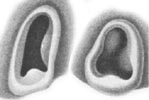
The Mastigoteuthidae, also known as whip-lash squid, are a family of small deep-sea squid. Approximately 20 known species in six genera are represented, with members found in both the mesopelagic and bathypelagic zone of most oceans. Originally described by Verill in 1881, it was later lowered by Chun (1920) to a subfamily (Mastigoteuthinae) of the Chiroteuthidae. However, Roper et al. (1969) raised it back to the family level, and this has not been changed since. The taxonomy of this family is extremely unstable, and there have been at times one genus, two genera and four subgenera(Salcedo-Vargas & Okutani, 1994), two genera and several 'groups', five genera and one species with an uncertain placement, or six genera.
Mastigoteuthis is a genus of whip-lash squid containing at least seven valid species. Some teuthologists consider Idioteuthis synonymous with this taxon.

Mastigoteuthis agassizii is a species of whip-lash squid. It is the type species of the genus.
Mastigoteuthis dentata is a species of whip-lash squid.

Mastigoteuthis flammea is a species of whip-lash squid.

Mastigoteuthis glaukopis is a species of whip-lash squid.

Mastigoteuthis grimaldii is a species of whip-lash squid.

Mastigoteuthis magna is a species of whip-lash squid, characterised by a lack of photophores. The skin is heavily pigmented a deep red by a numerous chromatophores.
Mastigoteuthis inermis is a species of whip-lash squid. Richard E. Young and Michael Vecchione consider it to be a junior synonym of the widely distributed M. magna.
Mastigoteuthis psychrophila is a species of whip-lash squid. It was first described by Kir Nazimovich Nesis in 1977, based on four individuals found in Antarctic waters. The largest was 143 mm long. The squid's tentacles are 15 mm in diameter, with 0.15 mm diameter club suckers. Integumental photophores are present upon the head, arms and fins. Although uncertain, it is believed to have more than two series of photophores on the arms, differing from other species in the M. agassizii group. However, this species, like the rest of the family, is badly in need of revision.
Mastigoteuthis pyrodes is a species of whip-lash squid.
Mastigoteuthis schmidti is a species of whip-lash squid.

Acratocnus is an extinct genus of Caribbean sloths that were found on Cuba, Hispaniola, and Puerto Rico during the Late Pleistocene and early-mid Holocene.

The genus Callophrys consists of butterflies in the family Lycaenidae. It is apparently not monophyletic, but which of the taxa currently considered junior synonyms of Callophrys are valid genera remains to be determined.

Magnoteuthis microlucens is a species of squid; the most common species of Mastigoteuthis around the main Hawaiian Islands.

Oliva bifasciata is a species of sea snail, a marine gastropod mollusk in the family Olividae, the olives.

Cephalopods exhibit various dermal structures on their mantles and other parts. These may take the form of conspicuous warts, cushions, papillae or scales, though in many species they are microscopic tubercles. The most elaborate forms are found among the oceanic squid of the order Teuthida.
Paraphyonus is a genus of blind cusk eels found in the Atlantic, Indian and Pacific Oceans. This genus was created for species formerly classified under Aphyonus when sampling of specimens showed that the type species of Aphyonus, A. gelatinosus, was not closely related to the other known species in the genus, including the newly identified species P. iselini and P. merretti. This work also brought Barathronus solomonensis into the new genus. The result of this classification is that Aphyonus would be a monotypic genus.
Margaret "Rena" MacDonald was an American athlete. She competed in the women's discus throw at the 1928 Summer Olympics.

Eumecostylus, or flax snails, are a genus of very large, air-breathing land snails, terrestrial pulmonate gastropod molluscs in the family Bothriembryontidae.











